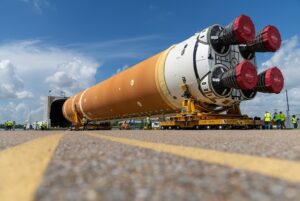NASA rolled out the SLS (Space Launch System) rocket’s core stage for the Artemis II test flight from its manufacturing facility in New Orleans for shipment to the agency’s spaceport in Central Florida. The rollout is key progress on the path to NASA’s first crewed mission to the Moon under the Artemis campaign.
The Boeing-built rocket stage, which is the largest component of the Artemis II mission, was loaded onto the Pegasus barge and transported 900 miles to NASA’s Kennedy Space Center in Florida. It will be integrated with the other Artemis II components, including the upper stage, solid rocket boosters, and NASA’s Orion spacecraft inside the Vehicle Assembly Building. This integration is a crucial step in preparation for the Artemis II launch, scheduled for 2025.
 “Boeing-built products helped land humankind on the moon in 1969, and we’re proud to continue that legacy through the Artemis generation,” said Dave Dutcher, vice president and program manager for Boeing’s SLS program. “Together, with NASA and our industry partners and suppliers, we are building the world’s most capable rocket and paving the way to deep space through America’s rocket factory in New Orleans.”
“Boeing-built products helped land humankind on the moon in 1969, and we’re proud to continue that legacy through the Artemis generation,” said Dave Dutcher, vice president and program manager for Boeing’s SLS program. “Together, with NASA and our industry partners and suppliers, we are building the world’s most capable rocket and paving the way to deep space through America’s rocket factory in New Orleans.”
The delivery of Core Stage 2 signifies a major achievement in the development of the SLS rocket. This core stage, measuring over 200 feet tall and powered by four RS-25 engines, alongside two solid-fueled booster rockets, will provide the 8.8 million pounds of necessary thrust to propel Artemis II and future missions into space.
SLS is the only rocket capable of carrying crew and large cargo to the moon and beyond in a single launch. Its unmatched capabilities will deliver human-rated spacecraft, habitats, and science missions to the moon, Mars and beyond.
Using highly specialized transporters, engineers maneuvered the giant core stage from inside NASA’s Michoud Assembly Facility in New Orleans to the agency’s Pegasus barge.
“With Artemis, we’ve set our sights on doing something big and incredibly complex that will inspire a new generation, advance our scientific endeavors, and move U.S. competitiveness forward,” said Catherine Koerner, associate administrator for NASA’s Exploration Systems Development Mission Directorate at NASA Headquarters in Washington. “The SLS rocket is a key component of our efforts to develop a long-term presence at the Moon.”
Technicians moved the SLS rocket stage from inside NASA Michoud on the 55th anniversary of the launch of Apollo 11 on July 16, 1969. The move of the rocket stage for Artemis marks the first time since the Apollo Program that a fully assembled Moon rocket stage for a crewed mission rolled out from NASA Michoud.
The SLS rocket’s core stage is the largest NASA has ever produced. At 212 feet tall, it consists of five major elements, including two huge propellant tanks that collectively hold more than 733,000 gallons of super-chilled liquid propellant to feed four RS-25 engines. During launch and flight, the stage will operate for just over eight minutes, producing more than 2 million pounds of thrust to propel four astronauts inside NASA’s Orion spacecraft toward the Moon.
“The delivery of the SLS core stage for Artemis II to Kennedy Space Center signals a shift from manufacturing to launch readiness as teams continue to make progress on hardware for all major elements for future SLS rockets,” said John Honeycutt, SLS program manager at NASA’s Marshall Space Flight Center in Huntsville, Alabama. “We are motivated by the success of Artemis I and focused on working toward the first crewed flight under Artemis.”
After arrival at NASA Kennedy, the stage will undergo additional outfitting inside the Vehicle Assembly Building. Engineers then will join it with the segments that form the rocket’s twin solid rocket boosters. Adapters for the Moon rocket that connect it to the Orion spacecraft will be shipped to NASA Kennedy this fall, while the interim cryogenic propulsion stage is already in Florida. Engineers continue to prepare Orion, already at Kennedy, and exploration ground systems for launch and flight.
All major structures for every SLS core stage are fully manufactured at NASA Michoud. Inside the factory, core stages and future exploration upper stages for the next evolution of SLS, called the Block 1B configuration, currently are in various phases of production for Artemis III, IV, and V. Beginning with Artemis III, to better optimize space at Michoud, Boeing, the SLS core stage prime contractor, will use space at NASA Kennedy for final assembly and outfitting activities.
Building, assembling, and transporting the SLS core stage is a collaborative effort for NASA, Boeing, and lead RS-25 engines contractor Aerojet Rocketdyne, an L3Harris Technologies company. All 10 NASA centers contribute to its development with more than 1,100 companies across the United States contributing to its production.
NASA is working to land the first woman, first person of color, and its first international partner astronaut on the Moon under Artemis.
SLS is part of NASA’s backbone for deep space exploration, along with the Orion spacecraft, supporting ground systems, advanced spacesuits and rovers, the Gateway in orbit around the Moon, and commercial human landing systems. SLS is the only rocket that can send Orion, astronauts, and supplies to the Moon in a single launch.


